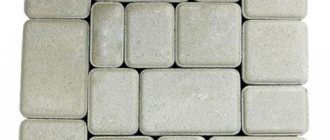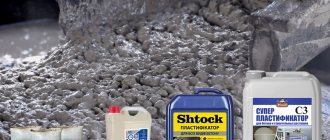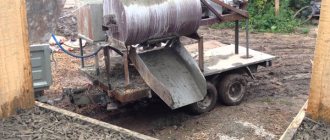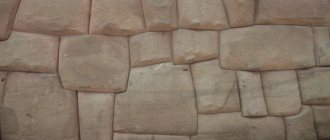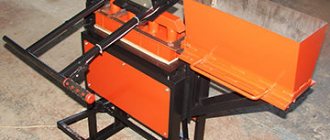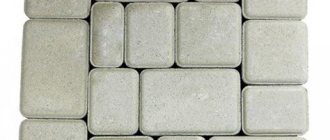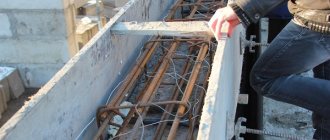A concrete plasticizer is used to improve the properties of the mortar. It is much more convenient to install it due to changes in the structure. The mixture acquires plasticity and becomes more uniform.
As a result, after hardening, concrete acquires increased resistance to external negative factors: temperature changes (high and low values of this parameter), aggressive environments. You can purchase a ready-made composition or make it yourself using available substances.
Hydration reaction and water-cement ratio
If you are wondering what a plasticizer is, you need to learn about the properties and structure of the substance. This is an additive used in the process of mixing concrete mortar. It is designed to improve the properties of the finished mixture.
Plasticizers for concrete increase the mobility of cement, which is due to an increase in such an indicator as plasticity. As a result, resistance to external factors increases, and at the same time, the service life of a structure made from this material increases.
The required result is achieved through a hydration reaction: when several components (cement, water, sand, additives) are combined, the process of hardening of the composition begins. After some time, the mixture turns into a durable cement stone. The hydration reaction is activated due to the ability of anhydrous clinker minerals to form calcium hydrosilicates. Without this, the concrete hardening process is impossible.
The resistance to external factors of the finished material is determined by the quality of the described reaction. Moreover, concrete has the best properties, which gains strength over several years. The properties of the solution are affected by the amount of water used. The best ratio of liquid to cement is 0.4.
However, it is difficult to work with such a solution due to the increased density, so the proportions are changed by adding more water.
You should focus on the structure of the material. Concrete should be characterized by moderate fluidity. To fill the formwork, a more liquid solution is used.
Changing the water-cement ratio leads to a decrease in strength. Structures based on such concrete do not last long enough. If you are interested in the question of why a plasticizer for concrete is needed, you should study its properties.
The additive improves the properties of concrete products, even if the proportions of water are disturbed. As a result, the material acquires the required strength.
Scope of application of plasticizers
The use of plasticizers for cement, due to the increased plasticity of the solution, can significantly reduce the time required for laying the material. These additives impart antifreeze properties to the mixture and allow the material to be used in aggressive environments and in places with high humidity. All these unique characteristics are in demand when organizing the following work:
- pouring complex-shaped structures with a high frequency of reinforcement cells;
- pouring monolithic foundations of various types;
- as an additive for plaster and masonry mortars;
- for pouring screeds in civil and industrial buildings;
- for the production of paving slabs;
- for the production of concrete blocks, slabs and other load-bearing products.
Action of plasticizer.
Purpose
Properties provided by the plasticizer:
- increasing the fluidity of the solution, which allows you to maintain the properties of concrete when changing the proportions of water and cement, and also improves workability;
- thanks to additives, cement is saved (up to 15%), while the strength does not decrease, but, on the contrary, increases significantly (up to 25%);
- due to increased fluidity, it became possible to use concrete pumps, as a result, the speed of construction increased significantly;
- facilitating the pouring of formwork in cases where frequent placement of reinforcing rods is provided;
- self-compacting compounds are created;
- there is a need to improve the properties of cement mortar in conditions where it is not possible to change the brand of cement to a more suitable option;
- if there is no vibration equipment, the additives in question are used.
Usage
When concrete is mixed, a plasticizer is used in large-scale construction. If in repair work it is necessary to use a minimum amount of cement mortar, it is not advisable to calculate a sufficient amount of material and prepare additives with your own hands. In this case, you can purchase a ready-made mixture, but packaging of the required volume is not always available for sale.
Despite a number of positive qualities, even the best plasticizer for concrete is not a necessary component when mixing a solution. However, it is preferable to use it.
At the same time, cement costs are reduced, construction work is facilitated, and properties are greatly improved. Therefore, the use of additives of this type is recommended from a financial and technical point of view.
To preserve the properties of concrete, you should follow the instructions for using plasticizing additives:
- Additives are used in accordance with the manufacturer's recommendations. It is important to follow the dosage indicated on the package.
- The plasticizer is introduced in dissolved form simultaneously with water.
- Work is carried out at temperatures above 0°C.
- If you plan to make plasticizers for concrete with your own hands, 100-150 g of dry substance or 200-250 g of liquid additive is considered sufficient for 1 bag of cement.
- The area where construction work is carried out must be dry. Thoroughly dried containers are used to mix the solution.
- Considering that bulk components are used during the preparation of the mixture, it is recommended to wear a protective mask. Dry compounds should not come into contact with exposed areas of the body.
- It is not recommended to smoke while preparing cement mortar. There should also be no other sources of fire nearby.
- It is prohibited to use materials whose expiration date has expired. They lose their properties, which means the quality of the finished concrete will be low.
Composition consumption per 100 kg of cement
The dosage of the additive depends on the operational characteristics of the concrete solution, the calculated content of tricalcium aluminate in the binder, the amount of active modifiers (excluding C3) and the dispersion of cement.
The amount of liquid plasticizing mixture recommended by the instructions should be 0.4-1% of the binder consumption. The optimal dosage is calculated empirically.
Manufacturers of modifying compositions recommend adding 0.5 kg of dry mixture and 3-5 liters of ready-made mixtures per 100 kg of cement.
Varieties
Existing additives:
- plasticizers;
- water repellents;
- accelerators and retarders of strength gain;
- antifreeze additives;
- seals;
- corrosion inhibitors;
- stabilizers.
The first option can be purchased in the form of a powder, a solution that is ready to use, as well as a liquid concentrate. The properties of such an additive were discussed above. Water repellents are used to attract air bubbles into the mixture structure. This measure makes it possible to reduce the intensity of surface tension, since the structure of the material changes: it acquires plasticity, the level of its mobility increases.
Stabilizing additives help maintain uniformity of the structure. As a result, the material retains its properties throughout the entire thickness of the layer during installation and during pumping. It does not lose mobility, strength, or ductility.
Another additive (densifier) is used to increase the density of the material, as can be seen from its name. The use of such an additive makes it possible to reduce the pore size of concrete. This helps to reduce the intensity of moisture absorption of the cement mortar. As a result, the material's ability to resist cracking increases.
Strength Accelerator
The main function of the additive is to increase the setting speed of the cement mortar; at the same time, the process of strength gain is 3 times faster.
Other properties:
- improvement in strength characteristics by 15%, while brand strength increases by 70%;
- the level of mobility of the finished concrete also increases, the material moves from group P1 to group P3, such changes in the properties of the solution make it possible to avoid the destruction of the structure under the influence of external factors (vibrations, precipitation, etc.);
- the heat of hydration increases;
- the intensity of water separation from the structure of the finished concrete is reduced.
Hardening accelerator can be purchased in liquid form. This additive is used when it is not possible to wait for the concrete to gain strength naturally.
Commercially available varieties of this additive:
- carbonic salts;
- sulfuric acid salts;
- ammonium salts;
- chlorides;
- nitrates.
However, formulations containing chlorides are most often used. They are highly efficient and reasonably priced.
Strength retarder
The component is used less frequently than the additives discussed above. This is due to the fact that the main purpose of using such additives is to reduce the rate of strength gain. The need for such a reaction is noted when extensive work is carried out and breaks are taken.
During transportation, it is also necessary to slow down the setting of the material. This will prevent the formation of working seams in the future. These areas are destroyed faster, because here the structure of the concrete is uneven.
The operating principle of this type of additive is based on influencing the hydration process. As a result, the strength of the mixture takes much longer to gain. There are physical and chemical retardants. In the first case, the cement grains are enveloped in a film, which helps reduce the rate of strength gain.
This method affects the reliability of concrete. Chemical action inhibitors require precise dosage calculations. Under their influence, the rate of natural growth of the concrete crystal lattice decreases.
Antifreeze additives
Can be purchased in liquid form. Thanks to such additives, the properties of concrete are preserved even with a strong decrease in air temperature - down to -20°C. At the same time, the hydration process slows down, which helps reduce the rate of heat release from the concrete layer.
It is advisable to use such additives if the finished solution will be used outdoors (installation of garden paths, production of foam and cinder blocks for the construction of external walls of the facility). It must be taken into account that the antifreeze additive is added to the solution only at sub-zero temperatures.
Corrosion inhibitors
Such additives are recommended for use when it is planned to build reinforced concrete structures. If the metal is corroded by rust, for example, in an area where the concrete has exposed steel bars due to damage, it is impossible to stop this process, since it will develop in the thickness of the durable material. However, it can be prevented by using corrosion inhibitors.
Under the influence of such additives, the oxidation reaction in the metal structure is prevented. If a corrosion inhibitor cannot stop this process, the additive reduces the intensity of the negative consequences.
The following types of additives are popular:
- sodium and potassium dichromate;
- a mixture of nitrite and calcium nitrate;
- sodium nitrite.
The corrosion inhibitor forms a kind of film on the metal surface. It prevents the oxidation of rods in the thickness of concrete.
Complex Supplements
They contain various additives, which improves the properties of the finished composition. If the question of how to replace a plasticizer for concrete is being decided, under certain conditions complex additives are considered. Another name for such substances is superplasticizers.
They are used if the finished structure will be regularly exposed to negative factors. The cost of complex additives is much higher than additives that perform one function.
You may also be interested in:
- Antifreeze additives in concrete and mortars are materials without which it is impossible to carry out construction work in conditions of subzero temperatures. One of the optimal antifreeze additives in mortars, the ArmMix NORDPLAST additive, makes it possible to carry out concrete work in the cold without heating the materials and subsequent heating of the laid concrete.
- Hardening accelerators for light and heavy concrete are additives to mortar and concrete that increase productivity by reducing the hardening time of concrete products and accelerating the turnover of forms. Also reducing the water-cement ratio.
Stamps
The number of varieties of plasticizing additives is quite large. In Moscow, the price may differ slightly from the cost in the regions. When choosing, take into account the properties and composition of the material.
In addition, pay attention to the environmental conditions in which the material will be used. Taking this into account, the necessary set of properties that should characterize the additive is determined.
Products of common brands:
- TechnoNIKOL;
- Hard Plast;
- Superplast;
- Doc Plast et al.
Muraplast FK 63
This is a water repellent for concrete mixtures. The additive can be used for stressed and non-stressed reinforced concrete structures. It is produced on the basis of a polymer of polycarboxylate esters. Properties of the substance:
- the composition provides a delayed absorption effect;
- the process of electrostatic repulsion is activated;
- thanks to this additive, strength increases at different stages of setting;
- you can switch to low grades of cement using a water repellent of this type, but the strength of the finished mortar does not decrease;
- increasing the service life of concrete structures based on such an additive;
- in the absence of vibration equipment, self-compacting concrete is obtained;
- the period during which the mobility of the mixture is maintained increases.
It is important to correctly determine the dosage of such an additive. To improve the properties, the solution should be prepared in forced-action concrete mixers. If you plan to use a water repellent of this type to prepare self-compacting concrete, it is recommended to simultaneously use a stabilizing additive.
The amount of such additive is determined as a percentage and amounts to 0.2-2.5% of the total mass of cement powder.
Frem Giper W
The substance is used to improve the properties of various structures. It is used when mixing mortar during concrete preparation, as well as for the construction of reinforced concrete structures. The composition is positioned as a hyperplasticizer.
The substance is produced based on polycarboxylates. Thanks to this additive, not only does the strength increase, but also the process of loss of mobility of the solution slows down.
This is a universal substance that can be used for the production of concrete mixtures for various purposes. Properties:
- ensuring a water-reducing effect;
- dilution of the concrete mixture to the required limits without loss of strength;
- mobility increases from level P1 to P5;
- the connection between the components is maintained;
- the duration of the formation of concrete products and the impact of vibration on the mixture are reduced.
C 3
This is a domestically produced superplasticizer. Can be used instead of foreign analogues. The consumption of plasticizer for concrete is small: no more than 0.7% by weight of cement. The material increases the fluidity of the mixture. It can be used to prepare self-compacting compounds.
At the same time, there is a decrease in water demand and a decrease in cement consumption. The superplasticizer retains its properties under the influence of high and low temperatures.
